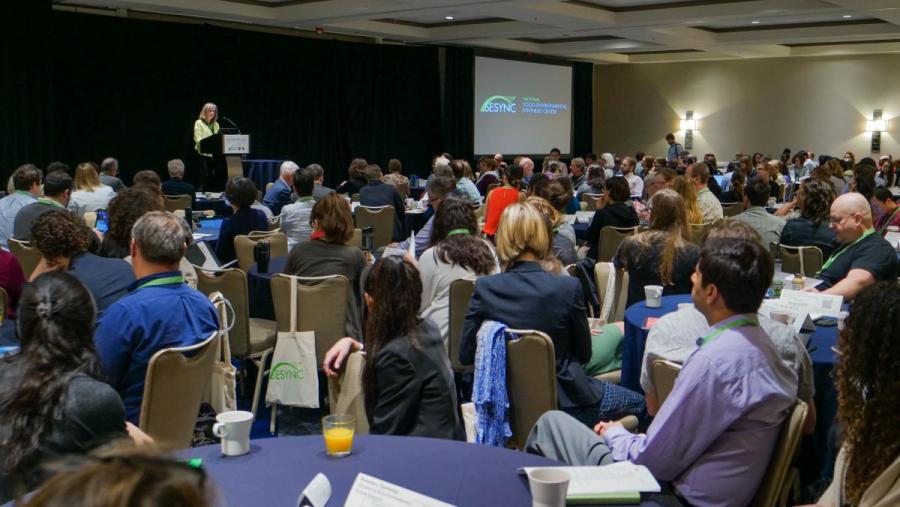
ANNAPOLIS—The National Socio-Environmental Synthesis Center (SESYNC) in partnership with the National Science Foundation (NSF), Resources for the Future (RFF), and the University of Maryland (UMD) convened its 1st international symposium June 11 to 13, 2018. Boundary Spanning: Advances in Socio-Environmental Systems Research brought together 244 leaders, emerging scholars, and other key individuals interested in innovating research and processes for solving socio-environmental problems. The participants came from 23 countries and 37 states and Puerto Rico to learn, share, and collaborate around socio-environmental research.
Over three action-packed days, symposium participants engaged in an array of activities, ranging from keynote presentations and panel discussions to lightning talks, poster sessions and early career networking events. The symposium was organized around three guiding themes—socio-environmental systems under stress, in transition, and by design—and participants left with a broad understanding of the current state of socio-environmental science and the important role that synthesis can play, explained SESYNC executive director Margaret Palmer, Distinguished University Professor at the University of Maryland.
The phrase “boundary spanning” means reaching out to build bridges across historic divides. In this context, the symposium connected and integrated diverse disciplines, sectors, knowledge, perspectives and goals – from academic, government, decision-makers, and others – to highlight research that accelerates actionable solutions to complex problems at the interface of people and the environment.
SESYNC opened its doors seven years ago with funding from the NSF. “There have been significant scholarly advances in several arenas but we are also now at a point we can see big hurdles that the research community need to clear,” Palmer said. The conference showcased many of the advances and discuss solutions to the challenges. “Our understanding of the linkages and feedbacks between social and environmental systems has grown immensely. Not only are previously unknown linkages being identified but our ability to quantitatively integrate theories of behavior change and decision making into dynamical models of environmental systems is opening new doors to inform policies,” she said.
Research teams SESYNC have identified linkages such as how upstream watershed conditions can predict children’s health in developing countries. Another SESYNC research pursuit integrated risk perception and subsequent behavioral response with climate change models to suggest that mitigation may benefit from new policies and communication strategies.
Certain topical or problem areas in socio-environmental research have attracted large and growing numbers of researchers. For example, SESYNC-supported teams have found the link between governance structure and natural resource outcomes; fisheries management and protected areas; and land use change drivers and consequences. Other areas are “research-starved” but exceedingly important, explained Palmer. Examples include all aspects of research linking behavior and behavior change relevant to environmental problems, environmental management beyond land use change, and human health.
“At SESYNC we have seen dramatic growth in the number and depth of interactions among scholars from disciplines who have rarely collaborated,” Palmer said, adding that environmental historians and geoscientists; philosophers, legal scholars, and ecologists; psychologists, medical entomologists, and evolutionary biologists have all taken part in science teams. “Interestingly and perhaps somewhat related, we are witnessing dramatic changes in department affiliations, degree titles, and how researchers characterize themselves …. the boundaries between some disciplines are blurring.
Part of the motivation for the symposium was to find paths to overcome hurdles in research. “Despite the widely held view we are in the age of data excess, most socio-environmental problems suffer from either lack of data--especially social--or an inability to obtain or easily use existing data,” said Palmer. “Many problems can only be addressed at broad scales because data are collected at the country or, sometimes, somewhat smaller levels but they are only available in aggregated form. Yet understanding the underlying social and ecological processes and linkages typically requires finer scale resolution.”
Keynote speeches by Michael Watts, Chancellor’s Professor of Geography and Development Studies at the University of California, Berkeley; Susanne Moser, director and principal researcher of Susanne Moser Research and Consulting; and Ray Hilborn, Professor of Aquatic and Fisheries Studies at the University of Washington, represented diverse perspectives within socio-environmental systems fields. Other talks by theme leads including Lori Peek, of the University of Colorado, Boulder; Tim Kohler, of Washington State University; and Joan Nassauer, of the University of Michigan, contributed valuable insights and inspired next steps for boundary spanning opportunities.
The University of Maryland’s National Socio-Environmental Synthesis Center in Annapolis is a National Science Foundation-supported center that brings together the science of the natural world with the science of human behavior and decision making to find solutions to complex environmental problems. SESYNC is funded through an NSF Award to the University of Maryland.